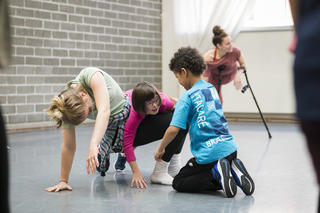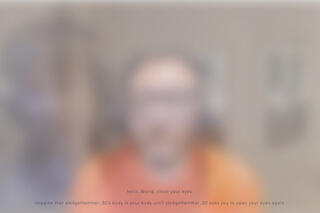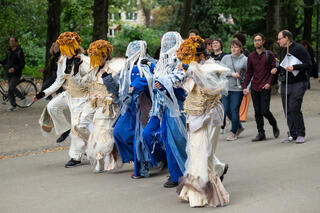Backstage with Charlotte Triebus

Hello Charlotte, you do work as a multidisciplinary artist while you are also a an artistic-scientific associate at Mirevi Lab, a research facility at the Düsseldorf HSD, with a focus on mixed reality and new technologies. In your artistic work, you tread along the intersections of art and technology. Let us begin with the basics: What is meant by the designations of mixed reality and new technologies, and why is it so interesting to connect these fields to dance?
Mixed reality (MR) designates situations in which real as well as virtual objects interact in real time and in which persons involved may also interact with said objects – be they real or virtual. MR encompasses the whole of the reality-virtuality-continuum, with the exceptions of strict reality and pure virtuality. Art oftentimes deals with a question for reality. Therefore, the question for reality and virtuality – and whether this distinction is still relevant at all – is of special importance. Every technology is an expression of its zeitgeist. Perceived as a tool, utilised as such, it is no different from a hammer, a sewing machine, a computer, a system. In our case, we look at the technologies within the artistic processes of dance, researching them, researching with them. They are embedded technologies for us – tools we handle with art.
Just as a hammer becomes a part of the body within Walter Benjamin’s thinking, this holds true for other technologies and systems as well. In the digital reality, which would accordingly expand the body, too, the status of a human body becomes furthermore differentiated only as online or afk (away from keyboard), as per Legacy Russell’s ideas.
Regarding dance and art, I believe dealing with the present holds relevance: What moves us? What touches us? If we ask ourselves these questions today, fields that are digital will come into play, too – the internet, Youtube, immersion, and interaction – as well as technologies we employ as a matter of course. That dance should be dedicated to dealing with those fields is therefore a downright compelling task.
One emphasis of your work lies on the exploration of the potential in the overlap of art, dance, and technology. What are those potentialities, and how are they turned into experiences for your audience within your work?
Art and dance were separate discourses for long enough. The philosophies and the questions in both fields, however, do intersect. Artistic research – meaning working on questions with the means of art, questions expressed in dance, which might even negotiate digital topics, may therefore be an attempt to create intersections between those two disciplines. It perhaps also offers impulse for thought on the part of the audience, or it might present context in which the audience has not yet experienced technologies.
I am very much fundamentally intrigued by the term post-digitisation which describes the situation in which “analogue” and “digital” cannot be distinguished any longer. I believe dance and art cannot choose to ignore technologies, because even political and ethical questions are questions we should actively negotiate as a society, while art may refer to them in yet another distinctly different way, compared to other sectors.
What is the starting point as well as the point of interest of your new work Precious Camouflage?
My work revolves around agents (in the sense of actors), around concepts and systems, around language between agents. Dance is language. Precious Camouflage is about the ability to interpret between languages – a particularly human faculty. In the context of artificial intelligence, the question of what is meant by intelligence here is swiftly raised. When should we talk about intelligence? AI needs to be able to interpret. Or is it simply the imitation of interpretation which we perceive as intelligent?
Precious Camouflage is a piece for four dancers and several AI systems who engage into shared communication. All agents on stage use the languages and forms at their disposal to talk about bodies, and occurrences, and dance. Simultaneously, even if it possibly remains largely invisible, my pieces discuss the question of agency – I would like to be able to decide for myself when and how to communicate with systems, and I would like to grant the agents the option to do the same, too. On another level, political questions emerge from the work, which do not need to be answered at all, yet they may fill up the room as something that is sensually palpable – one could assert that it is a tangible political sensuality.
Which interactions and dynamics emerge on stage between the dancers and the AI systems?
The stage dynamics revolve around the question for the body and the movement within the systems and the systems within our bodies. It all comes down to the question of who controls whom – who influences whom – who moves whom.
A staging with AI systems in this way ultimately poses the question for the negotiation of being human in interaction with other, non-human systems and the agency, meaning the capacity for action inherent in the agent, within those structures.
Which challenges and opportunities do you observe in the relation between dancers and AI systems in the development of and the work on Precious Camouflage?
I believe we lack a fundamental understanding of how AI systems function. The first questions for the piece’s development were towards the appearance of the body in AI systems, and how AI systems could be applied meaningfully in art. I believe we have come closer to the answers to these questions while those approaches will also keep us occupied in the work with AI systems per se.
An initial challenge lies in the AI systems being trained with sets of data holding content that is strongly marked by the institution, the instance, and the people whose content was utilised. Because this results in drawing from a very unilateral worldview, the artistic usability of which I strongly doubt, we began to compile our own data sets.
The AI systems on stage all engage in live interactions with the dancers. Therefore, the interaction may only be anticipated on the level of enactment; much of the interpretation is decided by the systems. That is terrific and wanted, yet it demands a certain amount of submission of control on stage. I believe that admitting technology poses both a great challenge as well as a great asset within the debate.
Could you describe the development process of the Precious Camouflage AI systems for us?
I developed the AI systems for Precious Camouflage in collaboration with the Mirevi Lab at HSD. The process is subdivided into a research phase, the analysis of existing AI systems, and the analysis into how that may be usable and compatible with dance and art. At the following step, we work on erecting test structures and the development of proprietary systems; countless iterations, dismissals, new approaches. This ideally goes on until we arrive at proprietary systems that are conducive to the artistic process, and which then serve the further artistic development and which will also be on stage as part of a piece.
Both in research as well as in the arts, it is mostly white men conducting the research on AI systems or engaging professionally with the intersections of dance and new technologies. Why is it important that people who are active in these sectors represent social reality?
I regard it as positive if a society’s reality in all its facets gains representation. But especially when talking about artificial intelligence, this suggests an all-encompassing neutral intelligence. This is questionable because artificial intelligence is, after all, constructed by humans and trained by humans, thus at first also simply mirroring the opinions and prejudice of its creators or the respective systems or data banks utilised. In my opinion, it will become more and more important to be conscious of this so-called bias, dealing with it, as well as being able to categorise things into their contexts, learning to understand where they originated. The knowledge about the way in which AI systems are being trained and assembled opens possibilities of exploiting their characteristics for one’s own, to discuss them politically, for example, and to transfer the findings into other areas. The bias in everyday life can almost exclusively only be confronted individually – with diversely staffed teams, proprietary data sets, discussions on ethic foundations, and an active broaching of the issues at hand, without condemning the interaction with AI in the process.
You are the only German and, apart from one other person, only European artist officially endorsed by Open AI. Open AI is the company which, among other things, developed Chat GPT and DALL E. You are also part of an independent consulting artists’ committee as well as part of the Open AI ethics group. Are there questions in the field of ethics and artificial intelligence that are simultaneously being negotiated in Precious Camouflage?
I would say that all the questions I bring to the table at Open AI are also being negotiated within the piece, shown very consciously – or resonating subliminally. Precious Camouflage as a piece was conceived to put dance into an AI context, while setting both into the ethical and political dimensions. At Open AI, I provide counsel on ethical and political questions alongside international artists and creators, as an external organ. Because artistic work can be read as being political in and of itself, and while the usage of such systems also automatically deploys an ethical-political dimension, dealing with this not only unfolds in a sphere of general social relevance, but also within a relevance that is thus reflected, in its condensed form, in the piece Precious Camouflage.
In what ways does the use of AI systems in a choreography expand the understanding of dance as an artistic form of expression? How do such artistic constellations influence the future of the performing arts?
I do not perceive the performing arts as being separated from the other arts, nor from other sciences. I believe that, in the future, networking will gain importance, learning from each other and with one another. In a best-case scenario, this should hold true across the disciplines, the differences being in the way it is represented, in the manner in which it is conveyed. Showing a piece, being able to carry danced impulse back into science in this way, and putting technologies developed from the arts onto the stage, that is a beautiful way to collectively experiment on topics.
Apart from the Precious Camouflage piece, and in addition to further performative and museum-bound works on the theme, we are working on an ethics manifesto, as an offer and a platform to deal with arts and ethics in the field of AI.
Our dramaturge Philipp Schaus interviewed Charlotte Triebus




